Wade to Win
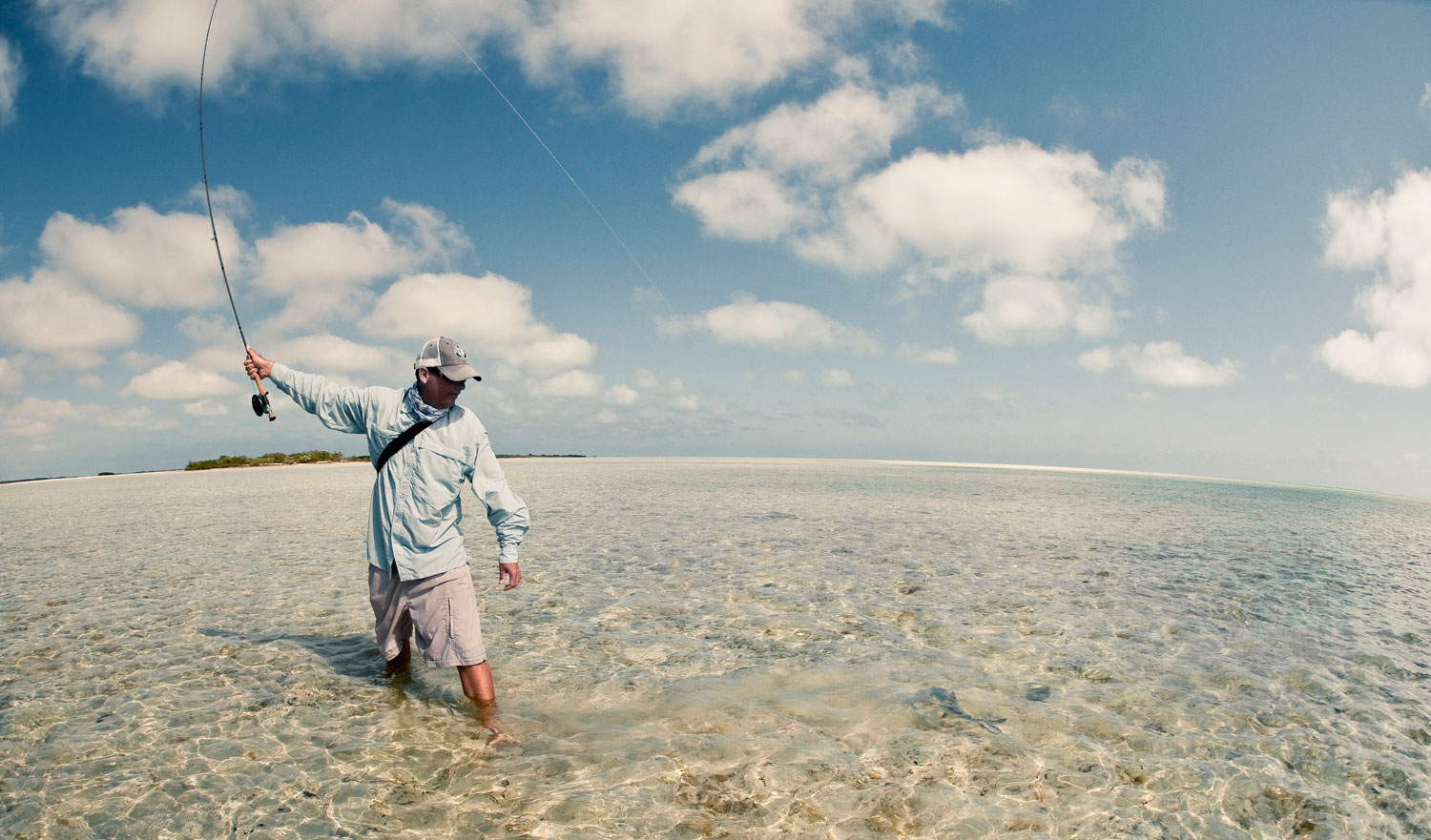
WADE TO WIN, BY BRUCE CHARD
Wading is an exciting way to experience saltwater flats fishing for species like bonefish and permit. It offers the angler a more personal, mano y mano, experience with his quarry. There are a few skills you’ll need to master for a quality wading experience. These tips should make walking the flats a breeze.
The Wading Ready Position
While wading the saltwater flats, it’s important to find a good, comfortable ready position. This position will help you be relaxed as you stroll quietly through the shallows. You’ll be ready to make a saltwater quick cast with ease.
Here are some pointers that make up a good wading ready position.
•Have the fly line, coming from the first stripping guide, pinched to the cork with your index finger. This helps to load the rod quickly on your first false cast.
•Hold the fly at the bend of the hook or cradled comfortably in your cupped hand.
•Do not let the fly touch anything, from the start of the cast until you present it to the fish. Some anglers like to drop the fly in the water and then cast. This motion causes all kinds of issues. They usually hook themselves and miss the shot.
•You can tuck the cork handle of the rod under you arm pit with the rod tip sticking out behind you . This is a nice way to relax a little and stretch your hands
Line Management While Wading
Here are a couple of fly line management tips that will help you when wading.
Fishing Fast
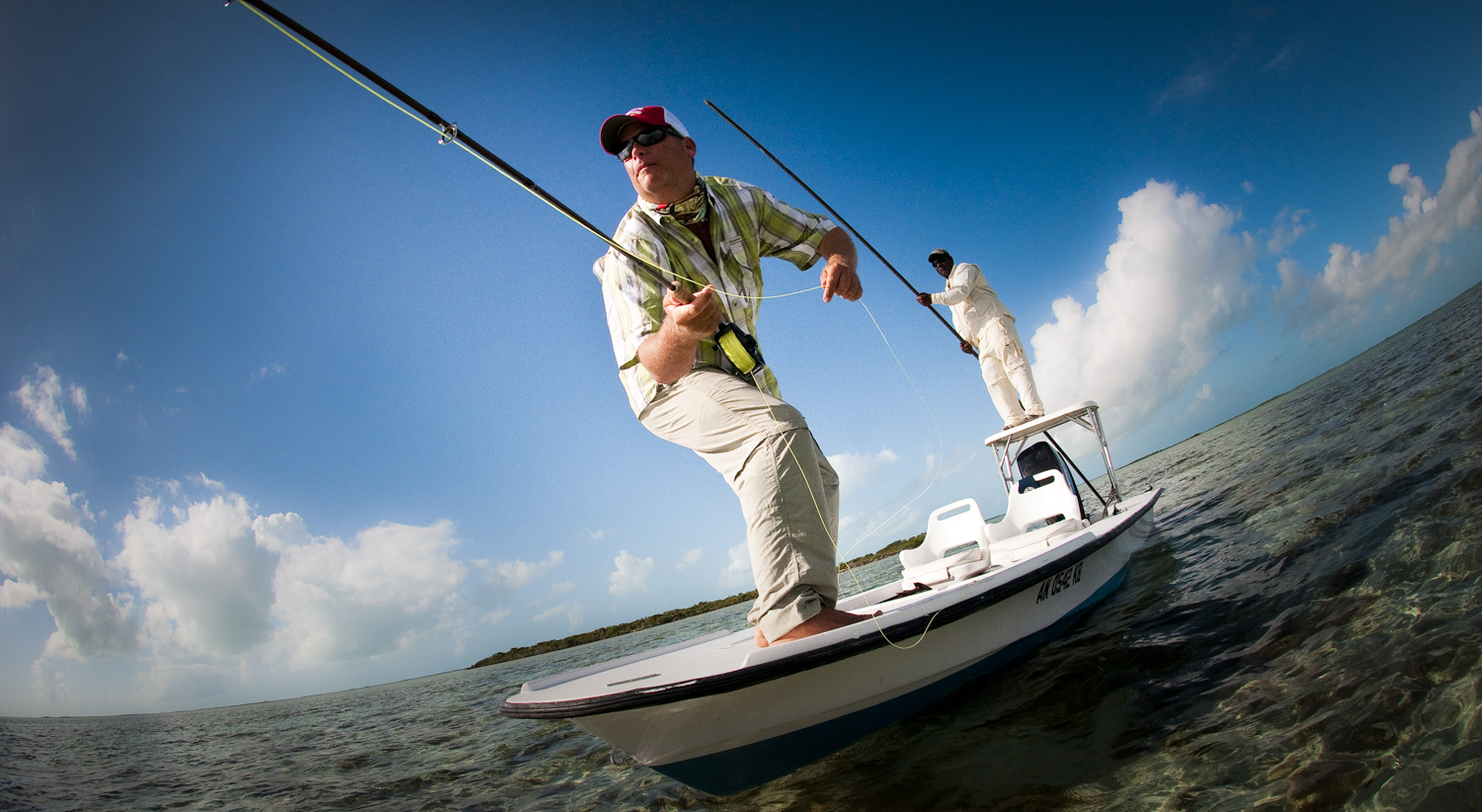
By Owen Plair
There are a lot of situations where fishing fast is the difference in getting an eat or the fish not seeing your fly.
Either because the fish is very close to the boat, or moving at an angle where you only get one cast. When it comes to sight fishing, we’ve all had that surprise fish. That one fish that seems to come out of the magical hat in a split second, 30ft of the skiff. There isn’t much time to present a fly to those close distance, or magic hat fish, but here are a few things that will have you prepared for fishing fast, and putting more magic hat fish on the fly.
HOW DO YOU FISH FAST OR EXACTLY HOW DO YOU DEFINE FISHING FAST?
The first, and most important, rule is being ready and aware on the bow. Keep 6-9 ft of fly line out of the tip of your rod while holding your leader or fly in your line hand. This is called the ready position and it’s key to getting a good first cast off. Keeping 6-9 ft of fly line out of the tip of your rod will help your rod load faster on the first casting stroke and allowing you to get that short distance between 20-30ft of fly line out very fast. Sometimes that 6-9ft of fly line along with a 9-12ft leader is all you need for an up close, in your face shot at a fish. Holding your fly or leader keeps the fly ready to fish, instead of dangling in the water getting the chance to hook up on the bottom or on a piece of grass when you go to cast.
Line management is a big part of being ready to fish fast. Make sure you always have enough fly line stripped out from the reel, usually safe with 30-60ft, maybe more or less depending on the fishing scenario. Most shots are between 30-60ft in your average sight fishing situation, so no need to strip out your entire fly line off the reel. That will just cause more heartache with tangles, especially on a windy day.
You want to have your line in a safe area, where there nothing to snag. Whether it’s on the bow, in a stripping bucket, or on the floor of the skiff. Your fishing partner can help with line management while fishing and also going bare foot on the bow will keep you from standing on line. In the colder months wear thick socks!
Understanding how to read the water, and spot fish will help you greatly. The thing I find works best is
Read More »Tom Rosenbauer’s 8 Tips to Becoming a Better Fly Fisher
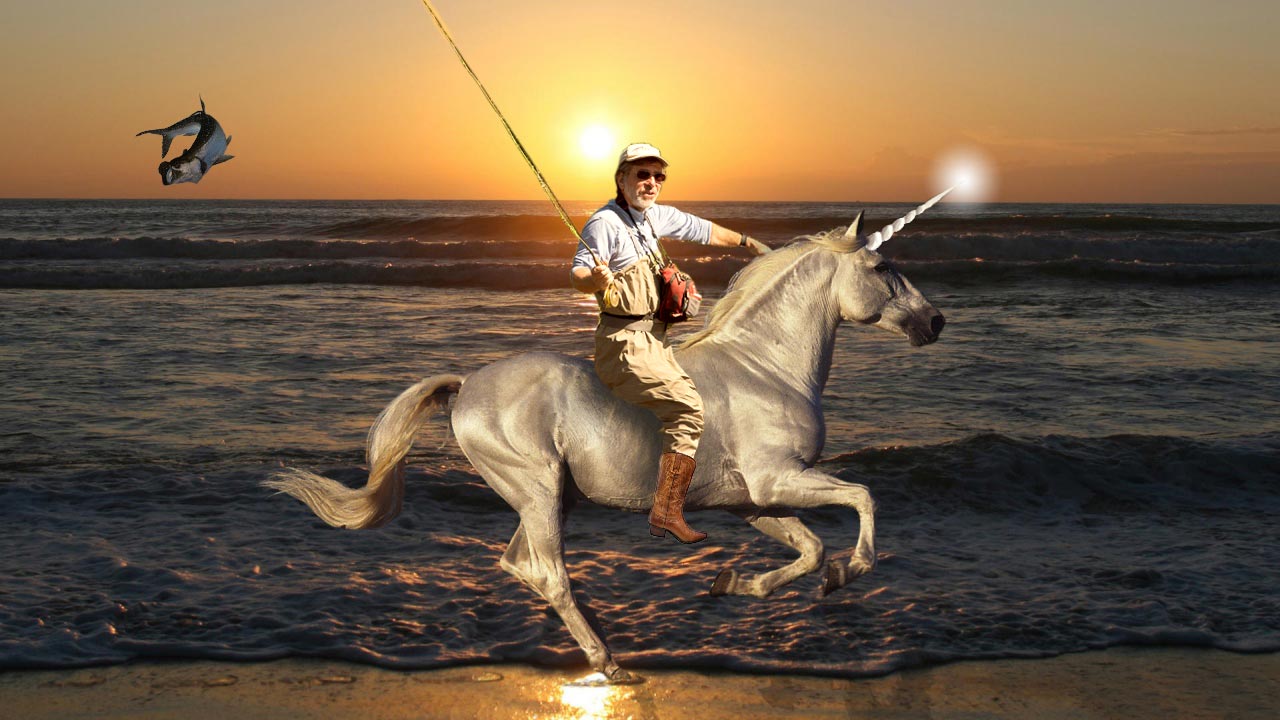
THERE ARE FEW GUYS OUT THERE SQUEEZING CORK WITH THE ANGLING CHOPS OF TOM ROSENBAUER.
Tom is the author of nearly two dozen books on fly fishing and too many articles to count. Add to that his podcast and posts on Orvis News and it’s fair to call him one of the leading educators in the field. Tom’s been an angler his whole life and was tying flies commercially when he was just fourteen. He has fished all over the world, including the English chalk streams, Christmas Island, and Kamchatka. He invented stuff you use every time you fly fish, like the magnetic net keeper and tungsten beads for fly tying.
Tom is now the Marketing Director for Orvis and a driving force in the rejuvenation of that great brand. A few people know that he also makes his own chocolate from the beans, which is incredibly technical not to mention amazingly delicious. He’s a hell of a nice guy and a good friend.
Tom has a lot to share on the subject of fly fishing so we asked him for some broad strokes. Some basic tips that will help you be a better and more satisfied angler. Here’s what he got back to us with.
Tom Rosenbauer’s 8 Tips To Becoming a Better Fly Fisher:
1. Observe everything. Look around every time you catch a fish and figure out why it was there and why it ate at that particular time. Look at the sun angle, the surrounding terrain, current threads in rivers, or highways on the flats.
Read More »The Snap-T Cast With 2-Hand Rod: Video
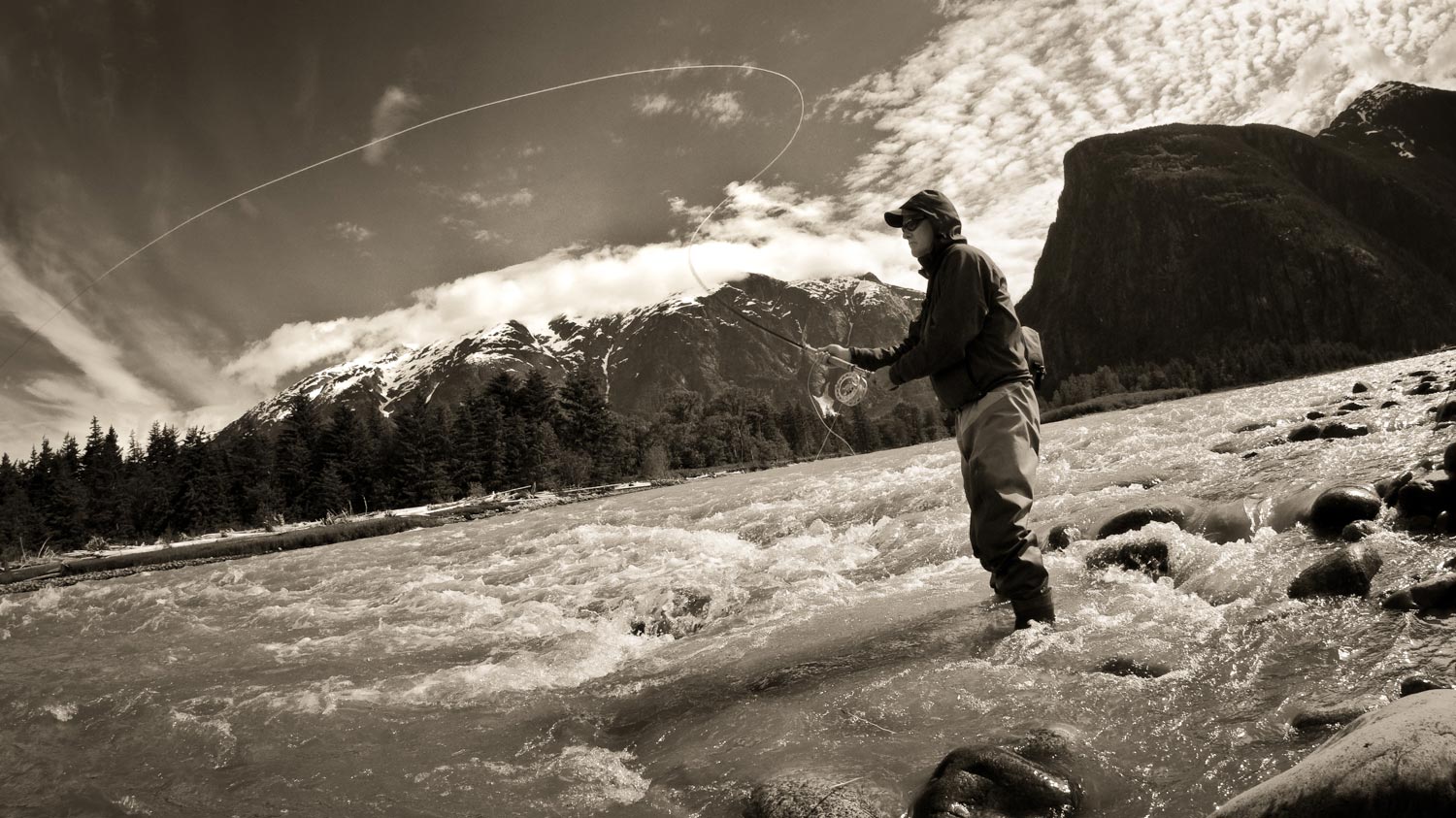
The Snap-T cast is an essential for any 2-hand angler.
You really only need to know a couple of casts to be an effective angler with spey or switch rods. One of the casts you just can’t live without is the Snap-T. This easy and powerful cast lets you launch the fly when the current is off your casting shoulder. It generates the power needed to cast heavy sink tips but works equally as well with light dry lines.
WATCH THIS VIDEO TO LEARN THE SNAP-T CAST FOR 2-HAND RODS.
Read More »Successful Fly-Fishing Is About Work Ethic
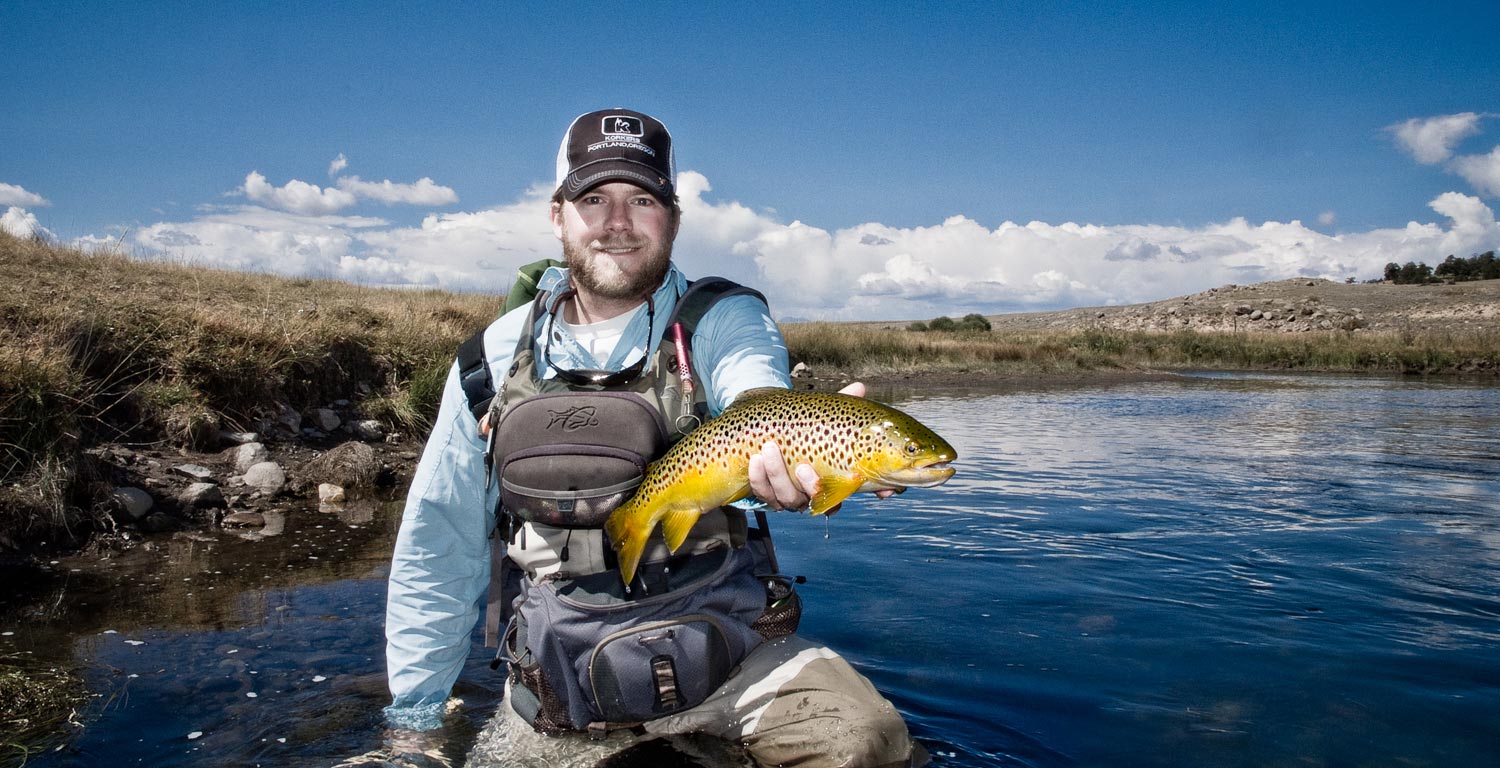
There are two types of fly anglers: those who treat it like a hobby and those who treat it like a job.
It’s not a judgment. There’s nothing wrong with being a casual angler. In fact, those anglers make me a little jealous sometimes, but the truth is we are not all wired the same and some anglers are more results-focused than others. Perhaps that means they want to catch a lot of fish, or big fish, or maybe you’re more motivated to master the skills than to catch the fish. One thing is undeniable: like so many things in life, if you are looking for fly fishing results, what you put in largely determines what you get back.
With that in mind, here are some thoughts on how to step up your fly-fishing game.
There are two places you have to display a solid work ethic to really boost your success. On the water and off. Off the water work is frequently ignored altogether but is the real key to success. There is something you can do every day to improve as an angler. It might be casting practice, fly tying, reading an article or watching a video. It might be swapping stories with a buddy over a beer. Whatever it is, the more you immerse yourself in fly fishing the more it becomes part of your nature.
Of all the things you can do off the water, I believe the most important is casting practice. After all, casting is the price of entry. There is no downside to being a good caster and it will not only make you a more effective angler, it will also make your time on the water more pleasant.
Casting practice accomplishes two things. It helps you develop new skills and it develops muscle memory to reinforce old ones. For that reason I always start my casting practice with the basics. I use a practice plan I learned from Tim Rajeff. Tim was kind enough to demonstrate it on video and you can watch that HERE. This practice plan is the perfect warmup and will do more for your fly casting than anything I know.
Once you’ve covered the basics, push yourself by working on your weakest skills or trying new ones. Maybe it’s a Belgian cast, a reach cast or a curve cast. Maybe you just want more distance or a better double haul. Whatever the skill you want may be, you can have it. You only have to put in the time. Even one day a week practicing will make a big difference. Better yet, practice more frequently for shorter periods of time and you’ll be amazed at the results. Get an Echo MPR for $35 and keep it at your desk. There’s no wrong time to practice.
The other place you want to get down to business is on the water. First, that means putting in the days. About twenty years ago I was talking with a casting instructor about doing some additional training.
“I don’t think I can help you,” he told me. “You know
Read More »Sunglasses: Don’t Leave Home Without ‘Em!

For many anglers, whether they choose to grab their sunglasses on the way out the door likely depends on the forecast.
“It’s going to be cloudy all day, so I’m not going to take them/wear them”. But, for me, I ALWAYS wear a pair of sunglasses, regardless of the weather that might be forecasted. While the amount of sun in the sky is one of the reasons why I always wear shades on the water, there are a couple of other reasons that are just as important.
Like I mentioned, the first reason to make sure that you leave the house with a good pair of sunglasses is to protect your eyes from the damage of harmful UV rays. Even when wearing a hat, the sun can harm your eyes and even cause burns to the surface of your eyeballs. Think of them as sunscreen for your eyes!
The second reason that I always wear a pair of sunglasses (and I’ll always recommend polarized lenses for this reason) is to aide me in spotting fish and wading safely. Polarized sunglasses redirect light so that it hits the eye more uniformly, thus reducing glare. This, in turn, allows us anglers to better see below the water’s surface. I carry a few pairs of sunglasses with me at all times and each pair has its purpose depending on the amount of sun on a given day. The other reason I carry multiple pairs is so I can offer my clients a pair so that they too can benefit from wearing a pair of polarized lenses while on the water. This helps both my client and me big time when it comes to sight fishing, as well as pointing out obstacles in the water.
The third reason why I will always wear sunglasses while I’m on the water is
Read More »Trust Your Guide
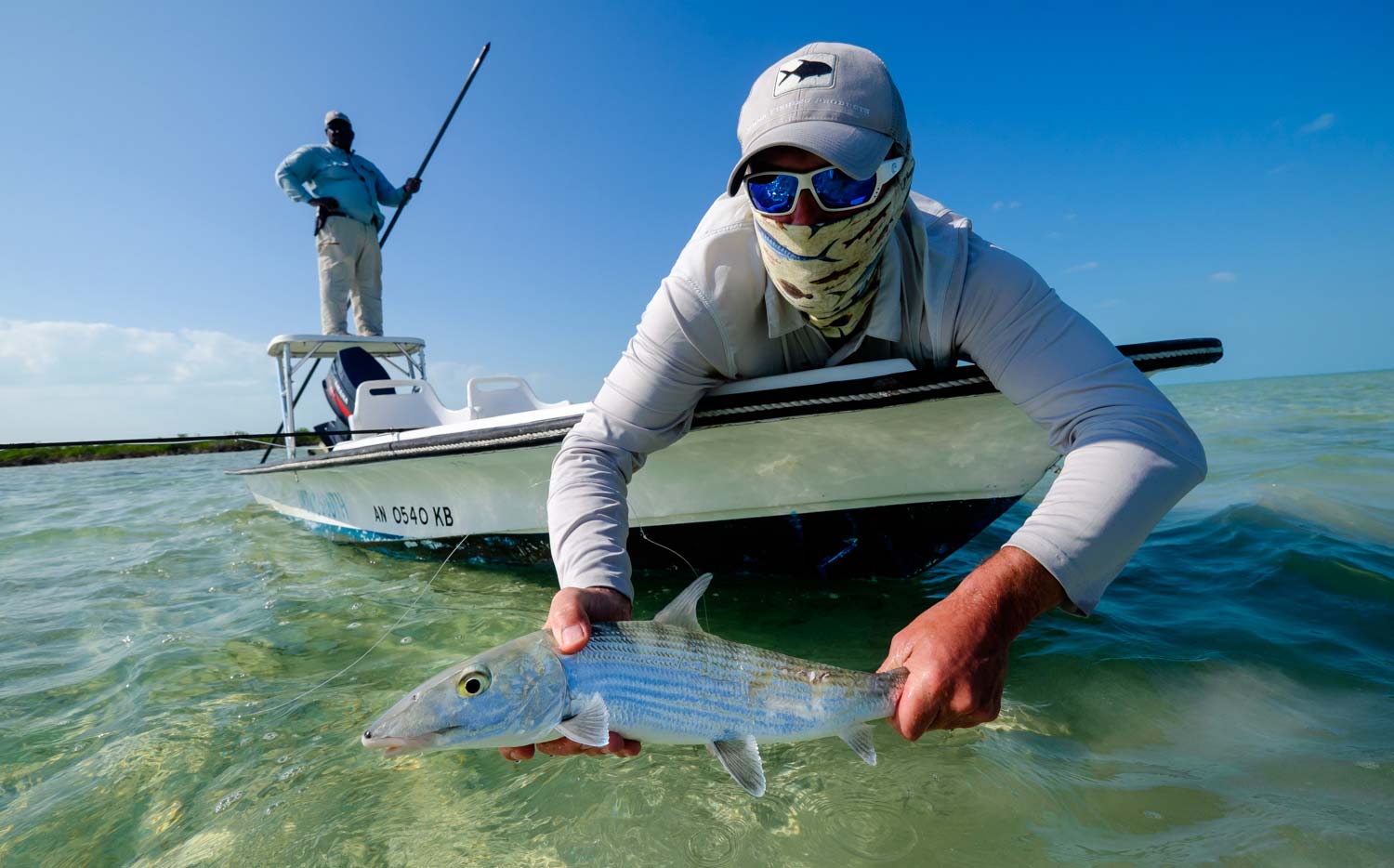
Trust your guide they say. Always trust your guide.
There is no more trustworthy bunch than the guides at Bair’s Lodge on Andros Island in the Bahamas. Why you wouldn’t trust them is beyond me. What is not to trust? In a real sense, in the South Andros backcountry, our lives will be in their hands- there is no freshwater, no cell phone signal, and I’ve taken to calling the miles of braided channels and flats with no distinguishing land features The Hall of Mirrors. If your guide cashes in his chips back here and peels off the poling platform, you are going to be royally screwed. If it weren’t for the sat phone in the emergency case, that is.
But it is one thing to carry your gear down to the skiff in the morning, shake your guide’s hand, look him in the eye and decide he’s trustworthy, and quite another to put that trust into practice on a flat with bonefish coming in hot. Perhaps we need to start our morning with those team-building trust drills that corporate consultants loved so much in the recent past. Put your fly rod down before you fall backward.
On one sunny Bahamas morning I found out what trusting your guide really means
Read More »Trout Of Japan
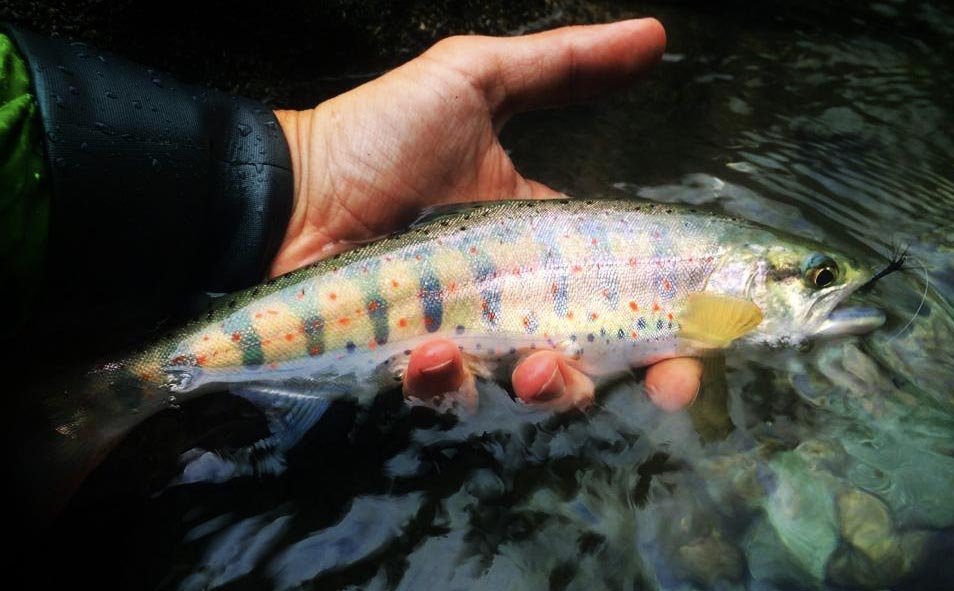
by Daniel Galhardo
“THE SEA-RUN FORM ASCENDS RIVERS OF JAPAN IN MAY WHEN CHERRY TREES ARE IN BLOOM AND THEREFORE IS KNOWN AS THE SAKURA MASU, OR CHERRY SALMON”.
As part of my mission of spreading the tenkara story to anglers outside of Japan, I have made a point to visit Japan every year. I’m currently on my 6th “pilgrimage” to the country, meeting with teachers who share with me their techniques, their insights into tenkara, and of course their favorite fishing spots where we search for trout.
There are two main types of trout that we target in Japan: the amago and yamame. There is also a char, the iwana (side note, most tenkara rods we offer at Tenkara USA are named after Japanese trout/char).
The amago and yamame are virtually identical, except that the amago features red spots thorough its body while the yamame does not. The yamame and amago are also referred outside of Japan as “cherry salmon”. In his book, Trout of the World, James Prosek explains “Among Japan’s many varieties of native salmonids is a beautiful pink and violet salmon that exists in both anadromous and landlocked forms. The sea-run form ascends rivers of Japan in May when cherry treers are in bloom and therefore is known as the sakura mass, or cherry salmon”.
Read More »4 Proven Ways To Effectively Fish A Streamer
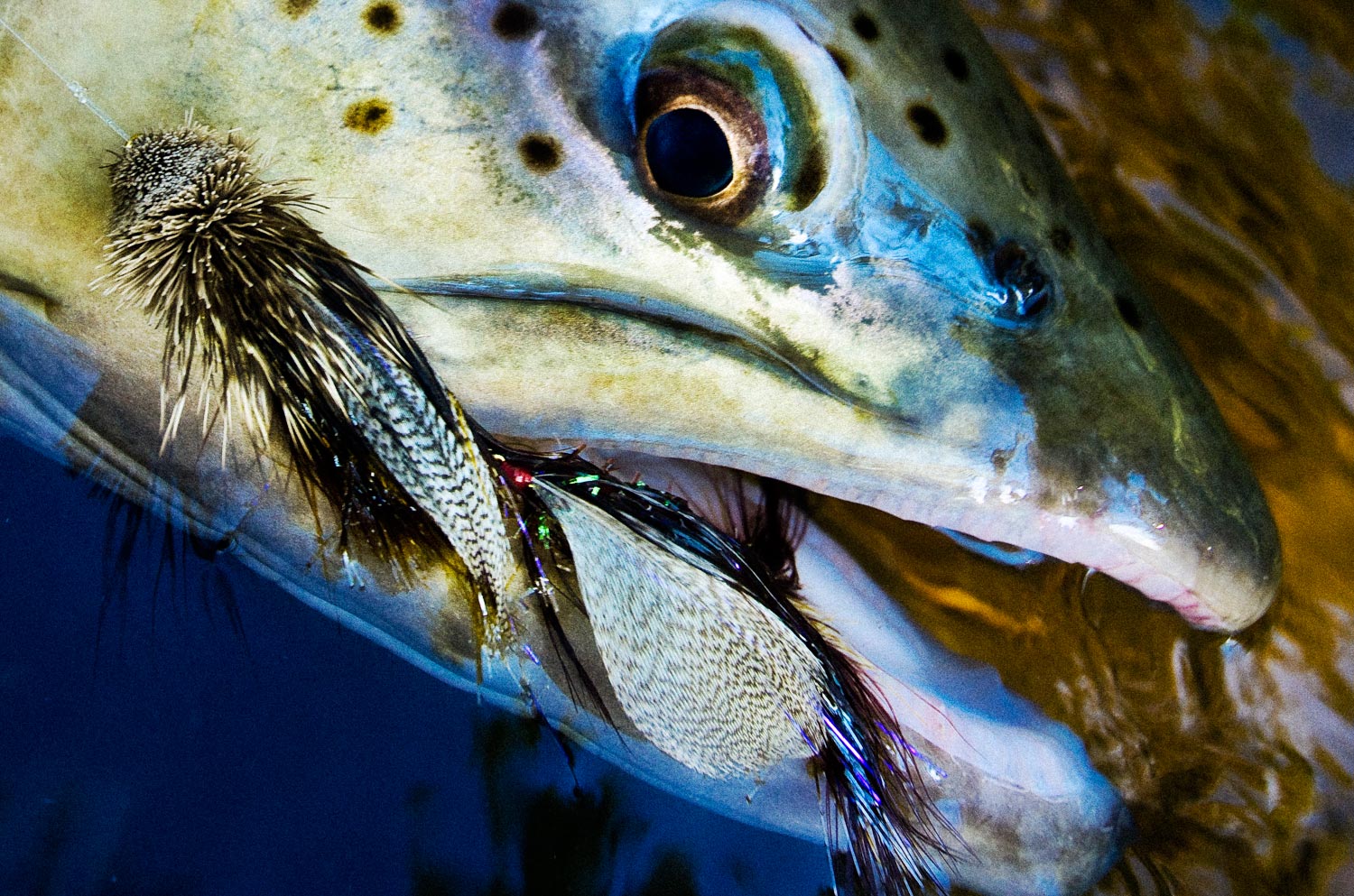
Every angler wants to catch a trophy trout and there’s no better way than fishing a streamer.
While it’s fair to say that there is no “wrong way” to fish a streamer, there are some proven techniques which will help make that trophy dream a reality. Presenting big, heavy flies to the largest fish in the river brings with it a whole new set of challenges, including a new way of thinking about presentation. Your presentation is no longer passive, but active, and it is the action of your fly which must excite the predatory instincts of the fish. In the end, you will find your own style of fishing streamers but here are four techniques that have been proven to bring big fish to the net time after time.
Stripping the fly
This is what most anglers think of as streamer fishing. Tossing the fly to the upstream side of a likely lie and ripping it back. It’s exciting and visual and usually productive. It plays on the predatory instinct of large trout by imitating a fleeing baitfish. I favor the jerk-strip retrieve, popularized by Kelly Galloup. A very young Mr. Galloup demonstrates in this video.
https://youtu.be/Pr_SwnIx6bA
The speed of your retrieve is key. Have you ever made an impulsive purchase that you later regretted? Then you have some insight into the mind of the fish who eats a streamer. Like a bargain shopper, fish don’t like to miss an opportunity. Your fly must be a limited time offer. If the fish has too much time to inspect and think his decision through, he’ll decide to pass. On the other hand, no fish wants to engage in the pointless pursuit of a bullet train. Remember to think about the environment where the fish and fly meet. If the water is moving slowly, your fly should scorch off the bank sending the message that it’s now or never. If your fly is in fast moving water, it’s already moving quickly in relation to a holding trout. Slow your retrieve down and give the fly a twitching action like a wounded baitfish. Always remember, a predator takes what he wants. It’s your job to make him want the fly.
Swinging the fly
If we set aside for the moment, the argument over whether steelhead are trout, this is how I have caught my largest trout. If a 42-inch steelhead will grab a swung fly, you’d better believe a big brown trout will, too. I like to employ the swing when fish are following a stripped fly, but not taking it. I’ll size down my streamer and often drop a Soft Hackle 16-24 inches behind it. You will catch more small fish this way but you’ll catch the big ones too.
Swinging the fly is an effective way to reach fish holding in
Read More »The Scream Revisited

By Louis Cahill
There was something going on with Edvard Munch I never really understood, until now.
In art school, we were taught that the dark and often disturbing images created by Munch were born of mental illness and lost love. It wasn’t until decades later that I looked closely enough at the background of his iconic work “The Scream” to realize what was actually happening. I too know the pain of having my ass handed to me on the flats, only to see my buddy hook up with the fish of a lifetime, right at the dock. Who wouldn’t scream?
They might have been right about the mental illness. It’s the only explanation for fly fishing.
Read More »